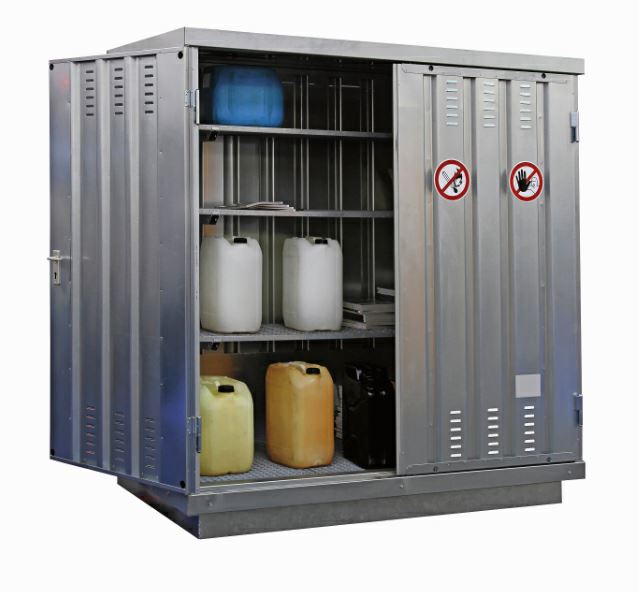The correct handling of chemicals
Companies that handle hazardous substances must ensure that employees, visitors, residents and the environment are protected from damage caused by these hazardous substances. The safety officer plays a central role in protecting employees.
The safety officer is only in rare cases a chemist or toxicologist himself and yet he has to deal with chemical hazards in the company. The following tips should help the safety officer to recognize hazards in connection with hazardous substances, to initiate sensible protective measures and to create the basis for further specialists.
Overview of hazardous substance inventory: What is used where?
The basis for determining chemical hazards in the plant is a complete overview of the hazardous substances used, their properties and locations of use. Filing all safety data sheets ensures that the most important information on the substances and safe handling is available. Knowledge of the existing inventory of hazardous substances is also a starting point for promoting the substitution of particularly hazardous substances with less hazardous ones and for identifying and dissolving products that are no longer needed in the plant.
For the safety officer, this means that a well-maintained list of hazardous substances, which is kept up to date at all times, and the filing of all safety data sheets must be demanded. In addition to the users and the purchasing department, two other specialists in the company can provide support.
Use support
Companies in which hazardous substances are used must appoint a chemicals contact person who has an overview of the handling of hazardous substances in the company and knows the obligations under chemicals law derived from this. The chemicals contact person is thus an important partner of the safety officer in recording, managing and assessing the inventory of hazardous substances. Likewise, the hazardous materials officer (GGB), if present in the company, can support the SiBe. The JCC has an overview of the dangerous goods relevant to the company as well as knowledge of the classification system according to ADR, which is very similar to chemicals legislation in many respects, and of the safe packaging and transport of dangerous goods on public transport routes. This knowledge can be used as input for questions regarding safe in-house transport, storage and behavior in emergencies.

Analyze workflows
If the inventory of hazardous substances in the company is recorded and assigned to individual storage and workplaces, the safety officer can specifically examine workplaces where hazardous substances are openly handled. Open handling results in an increased risk of exposure of employees, therefore, from the point of view of occupational safety and health protection, these workplaces are to be prioritized, in contrast to storage areas, where larger quantities of hazardous substances are located, but only in closed containers. Transfer and dilution processes in particular must be analyzed critically: By purchasing hazardous substances in suitable container sizes and concentrations, these work steps can often be avoided. Accordingly, the risk for employees is reduced. In addition to the activities themselves, the number of exposed persons should also be recorded and critically analyzed: working alone with hazardous substances should clearly be avoided, while at the same time as few persons as possible should be exposed to hazardous substances.
Ventilation during open handling
In hazardous materials storage facilities and at hazardous materials workplaces, the safety officer must be familiar with the type and design of room ventilation: Duct runs and air exchange rates of artificial room ventilation systems must be known, as well as the dimensioning and positioning of natural ventilation openings, so that in a second step it can be assessed whether the existing ventilation is sufficiently dimensioned to be able to safely remove hazardous substance emissions. Even without elaborate measurement campaigns or calculations, it can be stated that unventilated rooms, especially trapped rooms in basements, are unsuitable for work with harmful vapors or dusts. But incorrectly designed artificial ventilation is also problematic, for example if it transports hazardous substances not directly into the open air but into other work areas. Intense chemical odors as well as visible and long-lasting clouds of dust or vapor must be recognized as warning signs of inadequate or incorrectly designed ventilation and remedied.
Focus Ex Risks
In this context, special mention should be made of workplaces with explosion risks due to flammable gases, vapors or dusts. They must also be vented. In addition, artificial vents, like the other installations at the workplaces themselves, must meet the explosion protection requirements as described in Suva leaflet 2153 and the Atex guidelines. An incorrectly selected ventilation fan can become a deadly hazard in the vicinity of an Ex zone.
While dust explosion hazards are to be considered separately, the SiBe can base his identification of areas with explosion risks due to flammable liquids and gases on the already mentioned list of hazardous substances and search it specifically for products with the corresponding H-phrases: H224, H225 or H226 for flammable liquids and H220 to H223 for flammable gases and aerosols. A specialist can then be consulted as required for the further development of an explosion protection concept. Thanks to the prepared list of hazardous substances, the safety data sheets at hand and a good overview of the building ventilation, this specialist can quickly and efficiently carry out the necessary Ex zone classification and define appropriate protective measures.

Adapt PPE to hazardous substances and work process
The last point to mention is the correct use of personal protective equipment (PPE) at hazardous substance workplaces. Selecting the right PPE is particularly difficult in the area of chemical hazards: substance properties, quantities used and work processes must all be taken into account. Chemical protective gloves are a prime example: there is no universal glove material that effectively protects against all hazardous substances; different hazardous substances require different types of gloves, and it is not readily apparent whether a glove protects against a particular substance or not. If different chemicals requiring different glove materials are used in the same workplace, there is a risk of misuse by employees. It is advisable for the safety officer to be on the lookout for such problem areas. Once identified, various solutions are possible, such as the spatial separation of processes that require different PPE or the substitution of hazardous substances. If neither is possible, organizational measures such as illustrated work instructions must be considered. As a follow-up, the safety officer should regularly check whether the existing PPE is being used correctly and is adapted to the work process. If a glove model offers sufficiently good protection but is so thick that employees lack the necessary dexterity for fine work, then it is not suitable and alternatives must be evaluated.
The implementation of the tips described does not mean that the topic of hazardous substances has been exhausted. However, the risk posed by hazardous substances in the company is reduced to a large extent and important basic information is created for the consultation of specialists, e.g. for occupational hygiene clarifications, explosion protection or accident prevention.









